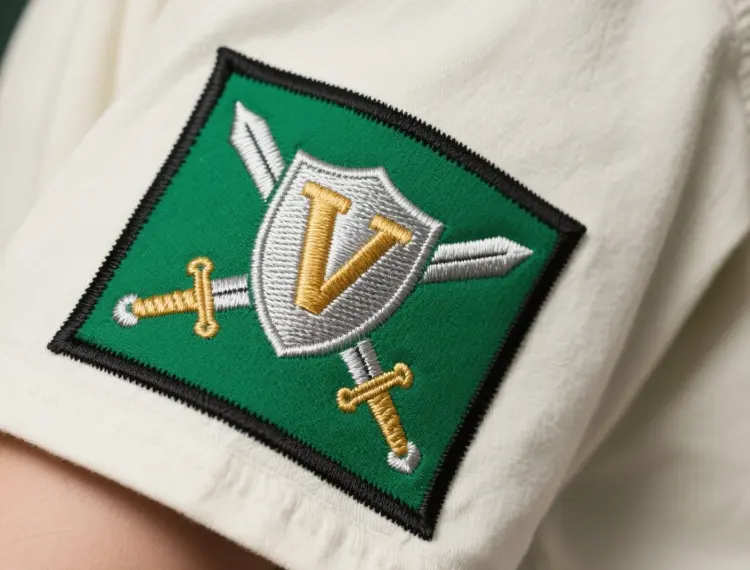U.S. military embroidered patches are an important part of U.S. military uniform culture, rich in historical tradition and symbolism. From the early days of simple markings to today’s standardized designs, the design, production, and use of military patches have evolved significantly. This presentation will delve into the historical development of U.S. military embroidered patches, with a particular focus on the evolution of the production process, especially pattern transfer techniques.

Early Origins and Development
The origins of military embroidered patches can be traced back to the 19th century and were initially used by British soldiers, but were limited to the officer class to show their higher rank. The U.S. military began to adopt the tradition in the early 1800s, but it was not until the American Civil War that embroidered patches became more widely used in the U.S. military.
According to sources, the history of military embroidered patches in the United States is relatively short. Some soldiers began wearing embroidered patches for identification purposes during the American Civil War (1861-1865). During this period, embroidered patches were primarily used to distinguish officers from enlisted men and were sewn onto uniforms to show the wearer’s identity and unit affiliation.
Embroidered patches during the American Civil War
During the American Civil War, embroidered patches were made by hand and the method of transferring the design was relatively simple. At the time, embroidered patch designs were often hand-sewn by professionals or by soldiers’ families, such as mothers and wives. Due to the limitations of handwork, embroidered patches from this period were crudely made and unofficially standardized.
During the middle of the American Civil War, when U.S. Army uniforms began to become standardized, detailed records of how embroidered patches were made and the techniques used to transfer them are still limited. However, it can be assumed that the transfer of motifs at this time relied primarily on traditional hand methods such as tracing and pouncing.
Pattern Transfer Techniques of the 19th Century
Traditional Transfer Methods
In the 18th century, design transfer methods for freehand embroidery were fairly well established. A variety of methods were used by both professional workshops and individual families to transfer designs to fabric. These methods included:
- Tying and Pouncing: this is one of the oldest methods of design transfer. The design is first drawn or printed on paper, then small holes are carefully pricked in the lines of the design, followed by shaking a charcoal or chalk bag over the zigzagged lines so that the design outline remains on the fabric in the form of dots.
- Tracing method: The design pattern paper is placed on the fabric and by tracing the lines on the paper, the design is transferred to the fabric through the paper.
- Pencil Transfer Method: Using a No. 2 pencil to trace the black areas on the back of the design paper, the design paper is then placed on the fabric and gently rubbed to transfer the design to the fabric.
These traditional methods were still widely used in 19th century embroidery production, especially during the American Civil War.
The age of mechanization
In the mid-19th century, the Industrial Revolution brought about the invention of sewing and embroidery machines, which revolutionized the production of embroidery patches.In 1828, Joshua Heilman produced the first hand-cranked embroidery machine, manufactured by Koechlin of Mulhouse and sold to Houldsworth of Manchester.In 1846, Josue Heilmann created a machine that could do the work of four hand embroiderers, complete with a frame and needle to hold the fabric in place.
The introduction of these mechanized devices greatly increased the productivity and standardization of embroidered patches, laying the foundation for the standardized production of military embroidered patches in the 20th century.
Military Embroidery Patch Development in the 20th Century
Industrialized production stage
The production of military embroidered patches became more industrialized and standardized as we entered the 20th century. During World War I, U.S. Army officials suggested creating embroidered patches for different divisions, which can be considered as early morale embroidered patches.
By the time World War II rolled around, Schiffli stitching had become the standard method of production for most U.S. military embroidered patches. Because this machine allowed for direct embroidery on fabric, it reduced the need for traditional pattern transfers.
Standardization of military embroidered patches
As military organizations expanded and formalized, the design and production of embroidered patches became more standardized. During World War II, companies such as O’Neil, Wm. F. Geis, and Scovill Manufacturing Company produced embroidered patches for the military. During this period, military embroidered patches became an important tool for identifying soldiers, their affiliations, and their honors.
Modern Military Embroidery Paste Technology
Digitized production technology
The production of modern military embroidery patches is fully digitized. Designers use computer-aided design software to create patterns and then transfer the digital files to embroidery machines. The embroidery machine embroiders the pattern on the fabric based on the design file, eliminating the need for a traditional pattern transfer step.
Innovations in materials and processes
Modern military embroidered patches use a variety of materials and processes, including heat transfer, embroidery, weaving and appliqué. These techniques have made the production of embroidered patches more efficient and the designs more intricate and detailed.
The history of U.S. military embroidery patches reflects the transition from handmade to industrialized production. In the 19th century, pattern transfer relied heavily on traditional hand methods such as tracing and tie-stamping. With the advent of the Industrial Revolution, the invention of sewing and embroidery machines greatly increased productivity and standardization.
In the 20th century, modern methods such as iron transfer technology and Schiffli stitching further simplified the process of transferring motifs to fabric, making the production of military embroidered patches more efficient and standardized. In modern times, digitized production techniques have completely changed the way military embroidered patches are made, making them more precise and diverse.
Regardless of technological advances, the importance of military embroidered patches in the culture of American military uniforms has remained constant, not only as a symbol of status and honor, but also as a testament to America’s military history and tradition.





